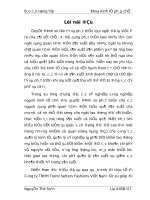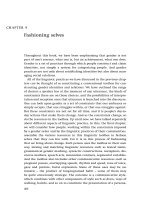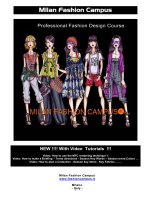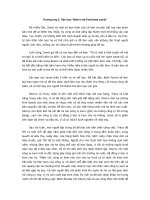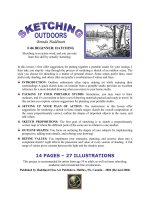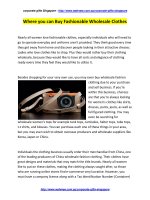Fashion sketching
Bạn đang xem bản rút gọn của tài liệu. Xem và tải ngay bản đầy đủ của tài liệu tại đây (3.89 MB, 59 trang )
<span class="text_page_counter">Trang 1</span><div class="page_container" data-page="1">
<b>FASHION ILLUSTRATIONS</b>
<sup>Tobias Konrath</sup></div><span class="text_page_counter">Trang 3</span><div class="page_container" data-page="3">Traditionally illustrations were made with pencil, ink and watercolours. Today ers and pens can do the trick as well and of course adobe Photoshop.
mark-It all starts with Skeletons, If you understand how the human body is constructed the rest will be a walk in the park and you can illustrate all sorts of poses, stands and materials.
Fashion sketching class will be all about experimentation and refining your drawing abilities, your knowledge of basic figures and fashion stands will be put to a test.The grey pencil sketches will come live .
</div><span class="text_page_counter">Trang 4</span><div class="page_container" data-page="4"><small>Advanced Diploma in Fashion DesignCourse Details</small>
<small>Course Title: Fashion SketchingCourse Code: FD-0352-05Credit Points: </small>
<small>Weekly Duration: 4Hrs</small>
<small>Pre-Requisite: Fashion Drawing (FD-0152-05)</small>
<small>Co-Requisite: Colour Theory for Fashion (FD-0150-05)Department: Fashion Design</small>
General Description
To provide the participant with the knowledge and skills through practical exercises and ples, to enable them to illustrate fabric textures and patterns on the fashion figure. To develop a sense of fabric movement, fabric draping and light reflections through the use of appropriate mediums. Students will have to successfully complete practical exercises and integrated project in order to complete this module.
<small>•PlagiarismPolicy•CollusionPolicy</small>
</div><span class="text_page_counter">Trang 5</span><div class="page_container" data-page="5"><b>The Sketchbook Project</b>
buy a good quality sketchbook with nice heavy paper, it should be around A4 size or bigger, like a square shape or maybe landscape, but not smaller than A4 of course. Bigger is better in this case.
A minimum of 40 pages is essential ,but you can also get 2 books with each one having 20 pages naturally.
This is important because you will need to divide the book into 4 sections of each 10 pages.- 1st part - pencil sketches and rendering
- 2nd part- watercolor pencil sketches
- 3rd part - watercolor/ Aquarelle illustrations- 4th part - Ink or pen sketches
- of course u can also mix the different medi, but then the major technique you are using counts.
<b>Grading Criteria</b>
You will be graded on your home work ( in your sketchbook) and on your classwork)
It is essential to work hard and show productivity. Dont worry if you are not so confident about your skills, as it is more important to show that you are learning and imroving from the begin-ning of the term to the end, no master has yet fallen from the skyes. ;)
Week 1 - warming up with pencil and shopping for required materialsWeek 2 - pencil and color pencil exercises with live model, study of drapesWeek 3 - pencil and watercolour excercise with model , study of drapesWeek 4 - pencil, pen and watercolour
Week 5 - pen sketches, pen + colour pencil
Week 6 - focus on the face, sketches in pencil and shading watercolour
Week 7 - intensive study of light and shadow and drades in pencil and watercolourWeek 8 - freestyle day with dressed up model, all techniques
Week 9 - freestyle day with dressed up modelWeek 10 - acrylic painting workshop
Week 11 - acrylic painting workshopWeek 12 - final exam
</div><span class="text_page_counter">Trang 7</span><div class="page_container" data-page="7"><b>Contents</b>
<small> IntroductionProject BriefLesson PlanSkeletons</small>
<small>The female figureThe male FigureThe anatomy of legsFaces</small>
<small>Light & ShadowDifferent AnglesDifferent FacesHands & FeetDrapesInspiration</small>
</div><span class="text_page_counter">Trang 8</span><div class="page_container" data-page="8"><b>Skeletons</b>
<b>T</b>
he human body is literally a big mass of water and protein hanging in and around a calcium frame. This frame is the skeleton, made out of many different bones. These bones are the key to drawing the human figure, they are simple to move around and manipulate. We start every pose with a rough sketch of the skeleton, it will reduce the risk to draw to big for the paper and at the same time keep the overall figure in the right proportions before we start the more elaborate drawing of details and clothes etc..The right page side shows how we construct a simple and rough sketch of the skeletal pose and then add body mass and ‘muscles’ to get the final pose --></div><span class="text_page_counter">Trang 9</span><div class="page_container" data-page="9"><b>S</b>
<b>keletons</b>
</div><span class="text_page_counter">Trang 10</span><div class="page_container" data-page="10">T
he classic stand is a figure with relaxed and loose hang-ing arms and straight legs, fully frontal. A fashion figu-rine is an over stretched idea of a normal figure, just like catwalk models are quite far from having a normal figure. Sometimes the human body proportions are split down and counted in ‘heads’ as the smallest unit. A nor-mal Person would be his or her head around 5 times in height where as a fashion fig-ure could be up to 8 or 9. If you closely study real fash-ion models on international catwalks, you will realise that they are not necessarily very tall or anything, but the have a very small head for a person of ca. 175 cm, which makes them appear taller.In this example shoulder width and hips have the same widthIf the shoulders are wider the figure will look more mascu-line, where as wider hips im-plymorefemininity.Elbowsand waist are on the same level. Wrists are roughly a bit lower than the crotch and the hands therefore even lower. For women the lower legs are generally longer than the up-per leg portion ( thighs)
<b>T</b>
<b>he female figure</b>
</div><span class="text_page_counter">Trang 12</span><div class="page_container" data-page="12"><b>The male figure</b>
T
he construction of a male body varies only slightly from that of a female. The main characteristics are:-Broader shoulders and smaller hips-Almost absent waist
-Upper and lower leg almost same length.
The general appearance of a male body is sharper and more chiselled due too less body fat and more mus-cles.
The 7 or 8 head idea remains and if we want to achieve a more masculine look we can play with the -V- shape of the body, meaning broader shoulders and smaller hips so it optically looks like the letter V. Also accen-tuating muscles will make it more masculine .
</div><span class="text_page_counter">Trang 14</span><div class="page_container" data-page="14"><b>L</b>
egs are not just straight lines with feet attached, due to the in-tricate play of muscles and bones under the skin, we can make out a distinctive shape.Well sketched legs are a sign of phistication and can improve any fashion sketch .
so-Legs should be long and slender with a sculptured knee and a faint idea of muscle, especially around the calf region in the lower part
</div><span class="text_page_counter">Trang 15</span><div class="page_container" data-page="15"><b>Legs</b>
</div><span class="text_page_counter">Trang 16</span><div class="page_container" data-page="16"><b>The Face</b>
<b>The soul of every Sketch</b>
</div><span class="text_page_counter">Trang 19</span><div class="page_container" data-page="19"><b>jaw-The female face</b>
T
he female face is loosely speaking a more oval shape, with smooth and round lines, giving a soft and aesthetic impression. Full lips and eyes with lashes make it feminine. The nose can be smaller and if the cheekbones are accentuated we can add some fierceness.The female eyebrows are usually a good bit higher up than the male eyebrows, this opens and enlarges the whole eye area, the 50% rules still apply.
On the next pages though I will explain what happens if we slightly shift those proportions
</div><span class="text_page_counter">Trang 20</span><div class="page_container" data-page="20"><b>Eye positions</b>
Depending on how the eyes are placed, the overall feeling of the face can be altered. In general low set eyes give a cute and child like appearance where as high set eyes suggest matu-rity and adulthood. The base posi-tion is in the exact middle following the 50% rules
<b>Normal eye position high set eyes- adult face low set eyes - baby face</b>
</div><span class="text_page_counter">Trang 21</span><div class="page_container" data-page="21"><b>Normal eye position high set eyes- adult face low set eyes - baby face</b>
</div><span class="text_page_counter">Trang 22</span><div class="page_container" data-page="22"><b>The 50% rule</b>
</div><span class="text_page_counter">Trang 23</span><div class="page_container" data-page="23"><b>Different angles</b>
</div><span class="text_page_counter">Trang 24</span><div class="page_container" data-page="24"><b>Light & Shadow</b>
Spotlight from above creates a mysterious shadow play accentuating the eyes and cheekbones, the overall appearance is slim and thin.
</div><span class="text_page_counter">Trang 25</span><div class="page_container" data-page="25">Light from either the left or the right upper side creates a natural and rather classic look. Accentuating the relief of the face and body making it more dimensional.
</div><span class="text_page_counter">Trang 26</span><div class="page_container" data-page="26"><b>Different angles</b>
With a little bit of practice and a good eye you can try to manipulate the position of the head. Turn it a bit to the left or right, show it in full profile, tilt it up or turn it down.
The skull illustrations taken from an old Thai ing handbook, a couple of pages earlier can give you an idea
sketch-of how the eyes and nose and mouth positions will change and the shape of the head looks like.
Especiallywhenworkingwithalivemodelwecanclosely study their faces from various points of view.The shadows that the facial features cast are essential to accentuate different angles.
<small>Looking down</small>
<small>Looking up</small>
</div><span class="text_page_counter">Trang 27</span><div class="page_container" data-page="27"><small>3/4 view</small>
<small>Full profile</small>
</div><span class="text_page_counter">Trang 28</span><div class="page_container" data-page="28"><b>Facial structure</b>
</div><span class="text_page_counter">Trang 29</span><div class="page_container" data-page="29"><b>Shadowplay</b>
</div><span class="text_page_counter">Trang 30</span><div class="page_container" data-page="30"><b>Eyes & lips</b>
<b>E</b>
yes can have various shapes and forms. Cat like, round, almond shaped, with or without a crease. The arch of the eyebrow usually corresponds to the outer edge of the iris.A simple rule is that the distance between the two Eyesshallbeaswideasoneeye.Themouthaboutthe same size or slightly bigger. Look at the lines on the right and how the facial features are ar-ranged and correspond to each other. This is not a random occurrence but based upon principles that determine the beauty of a face. As many oth-er things the beauty lies in proportions and even-ness.
Take a look at the various sketches of eyes and lips and you will see how just little variations changethelook.Especiallyforthelips.Formas-culine faces we try to keep the lines simple and light where as for feminine face we can accentuate them . especially the eyeliner area.
</div><span class="text_page_counter">Trang 32</span><div class="page_container" data-page="32"><b>Facial expressions</b>
</div><span class="text_page_counter">Trang 33</span><div class="page_container" data-page="33"><b>F</b>
aces can have a million different shapes and pressions, whatever expression you choose will di-rectly affect the mood of your sketch.ex-The easiest way to change the mood is by changing the eyes and lips, happiness, sadness, anger, an easy exercise.
The face plays an important role for your designs. The whole head is the soul of every sketch. Hair-style, shape and expression send out a message that can reinforce your ideas or do the contrary.
As you can see drawing hair doesn’t need hundreds of lines, each for every hair. The general shape and some lines to indicate strands are perfectly fine. Think of the hairstyle thing of the details, do they work with your clothes and the general idea of your inspiration?
</div><span class="text_page_counter">Trang 34</span><div class="page_container" data-page="34"><b>Hands</b>
</div><span class="text_page_counter">Trang 35</span><div class="page_container" data-page="35">Hands a masterful skill but better some simple lines than finger less stumps. Give it a try and you will find that it’s not so hard in the end. On the left side you can see an extract from the same vintage Thai sketching handbook, with beautiful illustrations of various hand positions.
</div><span class="text_page_counter">Trang 36</span><div class="page_container" data-page="36"><b>Shoes</b>
</div><span class="text_page_counter">Trang 38</span><div class="page_container" data-page="38"><b>Drapes</b>
</div><span class="text_page_counter">Trang 39</span><div class="page_container" data-page="39">Sketching fabrics needs a good eye and proper observation, there are no rules but looking close-ly at the intricate play between shadow and light that fabric drapes form gives an idea how to re-produce the same effect onto paper.
Since a human body is not a flat plane, fabric usually drapes around the body and somewhat reveals what underneath
</div>